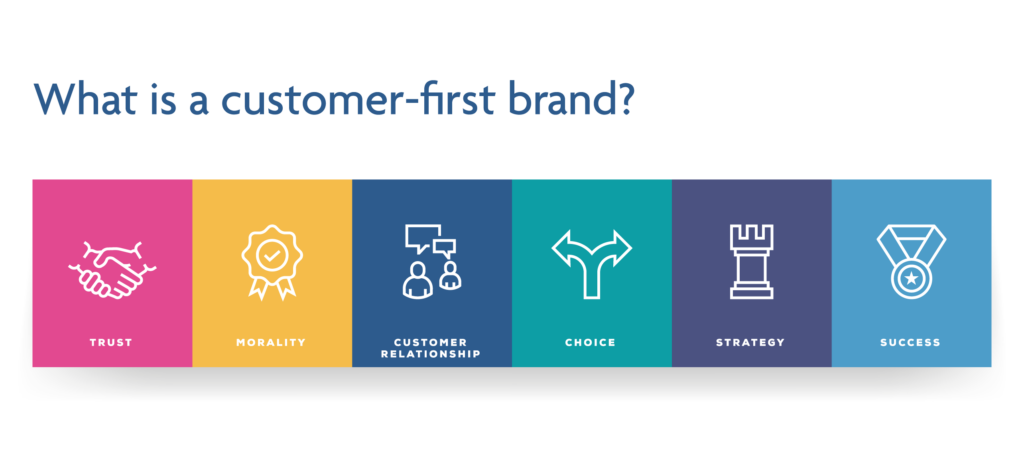Consistently putting your customers first is rule number one in the marketing handbook, but how often do you apply this principle to your customer service? In this blog, I look at building a customer-first brand experience – why it matters and how to be successful.
What is a customer-first brand?
That you should put your customers first in business, seems like an obvious thing to say, but far too often brands are guilty of doing just the opposite. A customer-first brand means considering your customer’s point of view in every decision you make.
It’s easy to set a strategic intent for your business and become so focused on achieving it, that you forget all about your customers – arguably the most important group of people that you’re responsible for managing.
Every step of the customer journey from beginning to end should be designed with them in mind. After all, the experience they have with you will dictate whether they come back and how likely they are to recommend you to their friends and family.
When your customers interact with your business, you can expect them to judge you on:
- How well you met their needs
- How easy it was to do business with you
- How enjoyable the experience was
For you to get top marks in all these areas, you need to know enough about your customers to be able to understand their pain points and anticipate their needs.
Why does the customer experience matter?
All too often businesses forget about customer service when they’re considering their branding, and yet, it presents a huge opportunity. Providing the customer with an unforgettable experience – in a good way – is a great way of building brand loyalty.
They say actions speak louder than words, and a customer-first brand experience is a great way of differentiating yourself from your competitors. And this isn’t confined to bricks-and-mortar stores because the user experience online is just as important.
Take Netflix as an example – they use their huge catalogue of programmes to give their customers personal recommendations on what to watch next. This is a business that lives and breathes its tagline ‘see what’s next’, and it’s paid off. The company went from 21.5 million paid subscribers in 2011 to over 158 million worldwide in 2019.
Every touch point/customer interaction they have with their audience, whether it’s through their social media accounts or contact centre, is aligned with their brand. In fact, it’s so on-message that many of the network original programmes have their own social accounts written in the tone of voice you’d expect for that show.
How do you build a customer-first brand?
There are four key elements to building a customer-first brand experience, and it all starts with understanding who your customer is and what they want.
1. Know and understand your customers
It’s easy to make the mistake of thinking, rather than knowing, what your customers want and delivering something that’s wide of the mark. With today’s technology on offer, there are ways of collecting vast amounts of data about your customers, but the key is knowing how to use that information to develop a better brand experience.
What are their pain points; what do they wish they could do better/faster/cheaper; how do they want to access your service or product? Knowing more about your customers puts you in the right place to anticipate and fulfil their needs better than anyone else.
2. Align your brand with your customer experience
To set yourself apart, align your brand with your customer experience. At the end of their journey, your customers should have a clear sense of what you stand for. That means making sure all the parts of your customer eco-system are on-brand, including your people – both customer-facing, behind-the-scenes, and even your chat bots!
Your people are an important part of the experience and if they are front-facing then they are responsible for creating the right impression of your business. To ensure a truly customer-first brand experience, give your staff the training and the support they need to do their best everyday. And don’t be afraid to recruit people who reflect your brand values and who you would be happy to represent your business.
3. Take a unified approach to customer service
There’s nothing worse than having a brilliant experience with a customer service representative, then ringing back the next day and experiencing something completely different. Or having a really efficient user-experience online then going to pick up a parcel in-store and finding the process is badly organised and stressful.
The key to ironing out these problems is to take a consistent approach. When you’re designing your customer journey, make sure that you apply the same strategy across every platform and at every touch point. That means involving all parts of the customer eco-system, bringing together different organisational teams, processes, and systems.
If the journey isn’t unified, you risk leaving your customers confused and dissatisfied.
4. Listen, learn, and evolve
The best way to improve your customer experience is to take note of your customer’s feedback – good and bad. Bill Gates famously said “Your most unhappy customers are your greatest source of learning,” and I agree with this. Though it can feel unsettling to read bad reviews and comments, it’s the best way to find out what went wrong. Once you’ve identified what could be improved, then consider making some changes.
With so much uncertainty in the world right now, customers want to be listened to more than ever. Brands that take the time to understand what their customers need are certain to win a competitive advantage – and now is the time to do it.
Do you need more help? I’m passionate about helping businesses to attract and retain customers with consistent messaging and design that helps improve their customer service. For help creating a customer-first brand experience that aligns with your messaging, contact me. You can book an appointment to meet me online or in-person – let’s have a brew.

